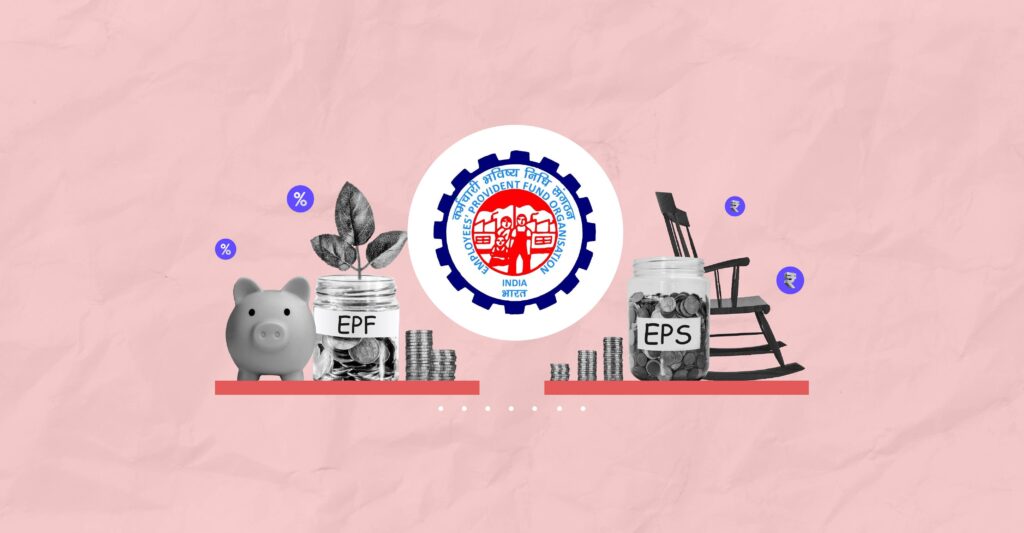Last Updated on Jul 28, 2022 by Anjali Chourasiya
The Government of India has launched various schemes to help individuals save money for their future. Two such schemes are the Employees’ Provident Fund (EPF) and the Employees’ Pension Scheme (EPS). The main objective of these schemes is to help individuals save for retirement. But, how different are they from each other? In this article, let’s explore the difference between EPF and EPS in detail.
Table of Contents
What is EPF?
EPF is a retirement savings scheme in which the employee and the employer contribute equally. It is a fixed-income retirement scheme that builds an employee’s retirement fund. It can be availed by the employee after attaining the age of 58 or if the employee is unemployed for 60 days or more.
Features of EPF
- Both employer and employee contribute 12% of the employee’s basic salary towards the EPF.
- The interest rate for EPF is reviewed by the Employees’ Provident Fund Organisation’s (EPFO) Central Board of Trustees. For FY 2022-2023, the interest rate is 8.10%.
- Withdrawal from the scheme can be made after completing 5 yrs of service.
- EPF is exempted from income tax after 5 yrs of continuous service.
- It is mandatory for organisations where there are more than 20 employees.
Calculation of EPF
Let’s understand the calculation of EPF with an example. Assuming the basic salary of the employee is Rs. 25,000.
- Employee’s contribution towards EPF = 12% of Rs. 25,000 = Rs. 3,000.
- Employer’s contribution towards EPF = 3.67% of Rs. 25,000 = Rs. 917.50
A percentage of the employer’s contribution goes towards EPS which is 8.33%. Hence, 8.33% of Rs. 25,000 = Rs. 2082.50.
Now, we calculate the employer’s contribution to the threshold income, which is Rs. 15,000. This is done for all employees salaried above Rs. 15,000. Hence, 3.67% of Rs. 15,000 = Rs. 1,249.50.
- Employer’s excess contribution= Rs. 2,082.50 – Rs. 1,249.50 = Rs. 833
This remaining amount is added to the EPF contribution of the employer.
- Employer’s total monthly contribution towards EPF = Rs. 917.50 + Rs. 833 = Rs. 1,750.50
Hence, the total contribution made by the employee and employer per month = Rs. 3,000 + Rs. 1,7450.50 = Rs. 4,750.50. It is rounded off to Rs. 4,750.
What is EPS?
EPS scheme aims towards social security. It pays pensions to employees. The scheme is available to all the employees who are members of the EPFO. They don’t have to contribute separately to this scheme; the only contribution employees have to make is towards EPF. However, the employer contributes 8.33% of the 12% share of the employee’s basic salary.
Feature of EPS
- Employees earning salaries up to Rs. 15,000 are eligible for this scheme.
- Employees will receive the pension after they attain the age of 58 and have completed 10 yrs of service.
- If the employee defers the pension period till they attain the age of 60 yrs, they will be eligible to receive the pension at an additional rate of 4%.
- In case the employee is unemployed for more than 60 days, they can withdraw the pension amount in full.
- The employee is no longer a member of EPS after attaining the age of 58. Even if they are working after attaining the age of 58, the employer is not entitled to contribute towards EPS.
Calculation of EPS
An employee’s pension amount depends on the pensionable salary and pensionable service. The formula to calculate EPS,
Monthly pension = [(Pensionable salary) x (Pensionable service)] / 70
Pensionable salary is the average monthly salary received by the employee in the last 60 months before they decide to exit the EPS. Whereas, Pensionable service is the duration of the employment of the employee. It is the total of service periods of an employee under different employers.
Let’s consider an employee’s salary to be Rs. 25,000. Hence, the contribution made by the employer towards EPS = 8.33% of Rs. 25,000 = Rs. 2,082.50. But, since the maximum amount an employer can contribute to EPS is Rs. 1,250, the excess amount is added to the EPF share of the employer.
Difference between EPF and EPS
| Features | EPF | EPS |
| Employee contribution | An employee contributes 12% of their basic salary. | An employee contributes nothing towards EPS. |
| Employer contribution | The employer contributes 3.67% of the basic salary of the employee. | The employer contributes 8.33% of the basic salary of the employee. |
| Contribution limit | There is no absolute limit for employees. They can increase their contribution. However, employers are not obligated to do so. The limit is expressed as 12% of the basic salary of the employee. | Contribution is limited to 8.33% on salary up to Rs.15,000, i.e.,Rs. 1,250 per month. |
| Eligibility for employees | All employees are eligible to apply for EPF. However, an organisation with more than 20 employees is eligible for EPFO. | Employees whose salary is up to Rs. 15,000. However, an employer with more than 20 employees is considered eligible. |
| Age of withdrawal | Employees can withdraw this fund after 58 years of age or if unemployed for more than 60 days. | Employees receive this pension after 58 years of age. |
| Early withdrawal | Employees can withdraw full funds anytime. However, if they withdraw it before 5 yrs of service, the withdrawn amount becomes taxable. | A lump-sum amount can be withdrawn from the fund after completing 10 yrs of service. |
| Financial benefits | Employees receive full amount and interest after retirement, i.e., after reaching the age of 58 or after 60 days or more of unemployment. | EPS provides a life-long pension after the age of 58 yrs. If the employee dies, the nominee gets the pension amount. |
| Interest rate | Interest is calculated every month and reviewed each year by EPFO’s Central Board of Trustees. The current interest rate is 8.10% per annum. | No interest rate is applied to the EPS account. |
| Tax applicable | The interest received from the EPF is tax-exempt. However, tax is applicable on contributions greater than Rs. 2.5 lakh. Further, if you withdraw the fund before 5 yrs, the Tax Deducted at Source (TDS) is applied at 10% on the EPF balance. | The lump-sum amount and pensions are taxable when received. |
| 80C deductions for employees | Deduction of up to Rs. 1.5 lakh of the employee contribution is exempted under Section 80C. | As the employee contribution is nil, there are no deductions. |
To conclude
The EPF and EPS schemes are both for employee welfare. If you are a salaried employee, it is necessary for you to understand the difference between EPF and EPS in order to avail their complete benefits. They both provide guaranteed returns, proving themselves to be two of the best retirement schemes.
FAQs
1. Is EPF better than EPS?
The EPF scheme provides you with a lump sum retirement benefit, whereas the EPS scheme gives you lifelong incomes. They both are beneficial for your retirement plan and help you build your savings.
2. Can I have both EPF and EPS?
When an employee signs up for EPF, they are entitled to receive EPS benefits. Employees do not have to contribute towards EPS; they only contribute to EPF. Employers, however, have to contribute 8.33% of the basic salary of employees towards EPS and 3.67% to EPF.
3. Is UAN the same for EPF and EPS?
Employees contributing to the scheme are allotted a Universal Account Number (UAN) by the EPFO. It remains the same throughout the employee’s service period. An employee does not need a different UAN for EPF and EPS. They can access all the relevant details using their unique UAN.
- Best Passive Mutual Funds in India: Top Index Options for 2025 - Mar 28, 2025
- Best Short-Term Mutual Funds in India for 2025 - Mar 28, 2025
- List of Top Small Cap Funds India for 2025 - Mar 27, 2025




